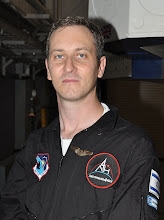 |
| Getting ready to go underwater. Credit: Guillaume Fortin |
It doesn't happen a lot. Many of us will go through life without an aircraft crash-landing. Most of us will also never win the lottery. However, some people do win the lottery, an event that statistically is far less likely to happen than a crash landing...
As part of my Suborbital astronaut training, after going through situational orientation, hypoxia and high-G training in March, I went to ProAviation in Canada and took their aircraft ditching, sea survival and underwater egress training course. I was a part of a group of 14 men and women whose work involves flying over water in helicopters and seaplanes.
After passing the border the night before to the country that reminded me of the TV series Sliders, where a group of people pass between alternate universes very similar to our own but with subtle differences. After passing the border I was in a place very similar to the United States of America, albeit with some small differences - the cable company name was different, temperatures were measured in Celsius and speed was measured in kilometers per hour.
The first half-day was spent with our instructor John Heiler in the classroom, going through several accident scenarios, what to do in order to be better prepared for accidents, what leads to accidents and how to improve one's chances of survival if a crash-landing happens in water or terrain. Complacency, the belief and over-confidence that nothing bad could happen, was a recurring theme and a leading factor in many cases where surviving the crash itself ended up as a tragedy.
Complacency is not alone causing loss of life. Alongside it has its sidekick, panic. Together, one before a crash landing and the other after, these dubious characters lead to mistakes, trivial in safe situations, cardinal and tragic when air-supply, body temperature and ultimately survival are at stake.
 |
| Swimming in groups, one of the pool exercises. Credit: Guillaume Fortin |
ProAviation has a simulator for practicing leaving a sinking, upside down aircraft. Two people, strapped in with seat-belts, are turned upside down and have to get out in various simulated situations, from simple no-doors with daylight to blind-folded or with their door not opening, with the goal of not only getting out but grabbing the life jacket in the process. After the first time, when I mistakenly pushed myself downward out of the simulated craft, I nailed it, eyes folded or door jammed, and gained confidence in my ability to internalize what needs to be done in such a case and being more ready for it. Duration of the exercises didn't pose a threat to holding my breath, as each one took about 12-15 seconds and (at least at rest) I can hold my breath for about 110 seconds.
Here is a video of two of my practice turns -
Granted, complacency would prompt me to decide I don't need to pay attention to aircraft safety because I went through the course. Many do it - go on a plane and do everything else except for listening to the safety instructions after boarding the aircraft; at best, we giggle when the flight attendants put the life-jacket inflation tubes in their mouth. After going through this course I know the opposite is the case. If panic would be at least in part mitigated by this course in an emergency I hope never comes, one of the important parts in any flight or situation on Earth or in space would be to be prepared and, regardless of the odds, know and mentally go through the way out when light is available, the aircraft is right-side up and oxygen is aplenty rather than try and figure it out when these comforts we take for granted might be missing.

 Space Shuttle Launch Poll Results
Space Shuttle Launch Poll Results













No comments:
Post a Comment